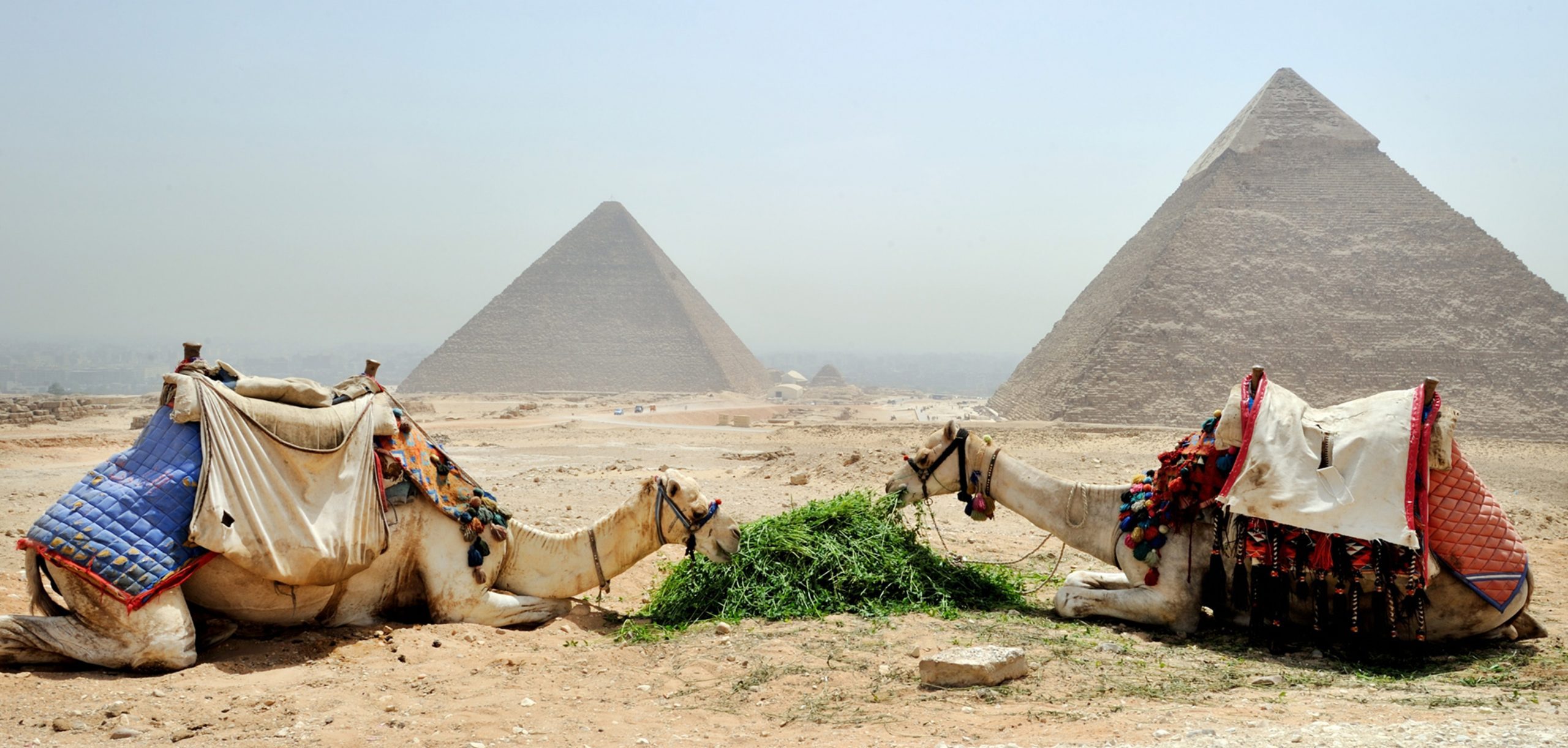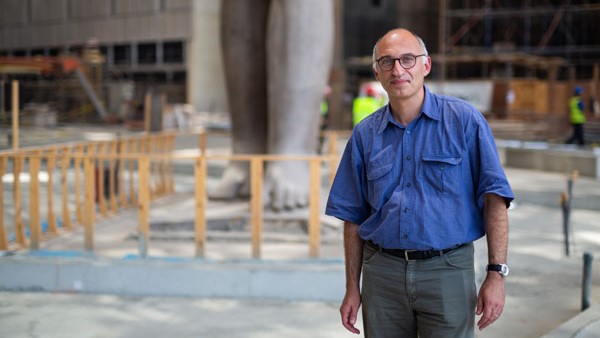A century and a half after Khedive Ismail Pasha hosted European royalty and financiers to celebrate the opening of the Suez Canal, Egypt’s leadership is preparing gala events to showcase the Grand Egyptian Museum.
Authorities have moved nearly 50,000 Pharaonic artifacts to the 120-acre facility scheduled to open in late 2020 and hope 4 million visitors a year will flock to the nation’s latest attraction.
The state estimates a direct return on investment of $840 million, including nearly 6,000 new jobs in construction, transportation and manufacturing with the museum becoming the prime economic growth engine for the Giza Plateau.
“Millions across the world will see the opening of the Grand Egyptian Museum, so we are preparing for the ceremony,” said Prime Minister Mostafa Madbouly at a press event in September. He sees the project as a crown jewel of a tourism industry returned to its place as a cornerstone of the nation’s economy.
Tourism accounts for around 3 percent of Egypt’s GDP according to the Central Bank of Egypt. In 2010, tourist arrivals topped 14.5 million, but by the end of last year they were 10.8 million. That, however, was a marked improvement from 2016, when only 5.5 million foreigners visited the country.
The social and political upheaval that began in 2011 led to a sharp drop in tourism revenue from its pre-revolution high of $12.5 billion in 2010 to $3.8 billion in 2016. Last year, however, revenue recovered to $11.4 billion.

“Tourism has long been vital to Egypt’s economy,” said Madbouly. “It’s not only about foreign currency inflows, which fix government finances. It is also about the millions of Egyptians who make a living from the sector. These incoming funds also help preserve the country’s history, culture and heritage.”
Even at the worst of the tourism slump, the government stepped up investment in the industry. The new museum will cost nearly $1 billion to build, compared to $23.3 million for the New Suez Canal.
While the museum is “exhibit A” for state efforts to make Egypt a more attractive destination, structural reforms include new legislation to help unlock the country’s full tourism potential. “Tourism is now the fastest-growing economic sector in Egypt, and its potential to attract foreign currency is the highest, fastest and easiest,” Madbouly said at a press conference in July.
In recovery
Despite its importance, the tourism sector still operates under a law passed in 1973. “It is an ancient law,” says Yousry Abdel Wahab, deputy chairman of Saudi Arabia-based Al-Tayyar Travel Group Holdings. “We now face a lot of new, ever-changing threats due to the rise of e-tourism, which opens the door to informal businesses.”
Over the years, only minor changes have occurred in Egypt’s tourism environment to make it more tourist-friendly, especially historical sites. “I don’t think anything has changed since I first came to Egypt in 2008,” Sylvia Ramar, a Ukrainian tourist, wrote in an email. She has visited Egypt every other year since 2008. “We still have to take a hotel car or bus to move around, especially if we are in Cairo or Alexandria. There is still no hop-on, hop-off service. Also, we are still using cash almost everywhere. All these things make our holiday a bit inconvenient.”

Reform plan
According to Tourism Minister Rania al-Al-Mashat, the government is undertaking structural reforms in the sector, such as the project known as Egypt’s Tourism Reform Program (E-TRP) announced in December. “In the past, the ministry was solving problems ad hoc, rather than creating a strong base for tourism to become sustainable,” Al-Mashat said during an AmCham luncheon in December. “E-TRP is our long-term strategy to make tourism sustainable.”
According to Al-Mashat, the plan is based on the U.N.’s Sustainable Development Goals. She stressed that making tourism sustainable would allow the sector to continue to perform well, even if there is significant disruption in the region. “My overarching objective is for at least one individual in every Egyptian household to work directly or indirectly in tourism,” she says.
E-TRP has four pillars: institutional and legislative reforms, promotion and marketing, infrastructure and tourism development, as well as catching up with global tourism trends. “The first step is to restructure the ministry to move skilled juniors to higher posts,” Al-Mashat said at the AmCham event. “The success of tourism requires people and hardware, which is infrastructure.”
State investment
For the current fiscal year, the government allocated EGP 1.4 billion for E-TRP. That will pay for upgrading Terminal 2 at Hurghada International Airport at a cost of EGP 486 million. During a July 31 press event, Civil Aviation Minister Younis Al-Masry highlighted a new 4-kilometer runway, better administrative facilities and security upgrades. “Our expansion plan aims to double capacity to more than 7.5 million tourists a year,” he said.
At the same event, Al-Mashat pointed to ongoing upgrades at all of Egypt’s airports. “It is common for tourists to arrive and depart directly to and from beachside resorts,” she said. “That is why all airports need to meet international standards.” Last month, the Civil Aviation Ministry announced construction of Terminal 4 at Cairo International Airport to boost capacity to 30 million arrivals a year.
Other infrastructure upgrades include increasing the capacity and size of the highway system, according to Saad. “There is a particular focus on upgrading roads and diversifying the transportation network in the western part of the North Coast,” he says. “The plan is to make it more tourist-friendly.” Currently, the area is visited mostly by locals during the summer. “We want more foreigners, all year round,” says Serag el Din Saad, head of the Tourism Development Authority.
He adds that plans are afoot to make it easier for tourists to visit cities such as Aswan, Luxor, Sharm el Sheikh and Hurghada. “We are planning it down to how many languages would be on road signs based on the most popular nationalities visiting each city,” explains Saad.
In addition to Tutankhamun’s new home at the Grand Egyptian Museum, the Giza governorate is working with several ministries to develop a dedicated zone for hotel facilities and connect the museum with the Pyramids via an EGP 500 million walkway. Meanwhile, the nearby International Sphinx Airport, which opened in January 2019, promises tourists direct, traffic-free access to the museum.

Standalone efforts
The government has also been automating various services that target tourists, starting with the 2017 launch of an online visa system covering 46 countries. Other digital services include reserving train tickets on the Egyptian National Railways website. There also are mobile phone applications for the railways and post office, and a tourist guide app developed by the Egyptian Tourism Authority.
“That digitization strategy is the perfect way to attract tourists,” says Hossam el Shaer, a board member of the Egyptian Tourism Federation. “Tourists will likely visit Egypt if they find online services and an abundance of facilitations to make their movement and holiday planning easy.” An online presence could also influence decisions on when to travel if the government uses digital channels to promote annual events. “That elevates the status of any tourist destination,” says Shaer.
Al-Mashat also highlighted her ministry’s work on creating a scoring system for tourist sites that allows visitors to rate and comment on hotels, facilities, services and their overall experience.
However, Shaer points out that behind those automated services there must be an “army” of employees with the technical and language skills required to interact with foreigners online.
On the regulatory side, Al-Mashat issued a directive in October 2018 to unify the financial support the state gives to regular airline companies and one-off incoming flights. It also decrees that the state must provide that “subsidy” to both airline and travel agents. Additionally, every six months the ministry will increase support to airlines and agents that increase the number of trips to Egypt during that period.
That program, however, will last only until April of next year. After that, the government will revert to its old incentives program that prioritizes regular flights over one-offs with subsidy money going to travel agencies.
Fresh start
Standalone attempts by the state to fix specific aspects of the tourism environment are not likely to make a recognizable improvement. Accordingly, the government is replacing the 1973 tourism law.
It sent an initial draft law to Parliament in February 2018 that is pending approval. “It is time we have a new law after 46 years,” says Kamel Abou Ali, founder of Pickalbatros Group, which owns 16 hotels and waterparks in Hurghada and Sharm el Sheikh.
Though few details of the draft law have been released, one highlight is that tourism-related businesses will deal with a sector-specific one-stop shop.
Many experts praised the plan for such a facility. “To operate in Egypt, we need to get different licenses compared to other industries. They include approvals from the army and security agencies, among other national and municipal government agencies,” says Abou Ali. “That is why we need the one-stop shop more than industrial and real estate investors,”.
The proposed new law would also regulate online-only enterprises, such as Airbnb, that target tourists. Such regulation might include licensing fees and taxes. “That is a new threat for us,” says Abdel Wahab of Al-Tayyar Travel Group Holdings. “We are not just competing with real-world informal companies. They are only on the internet, where they have access to more people, but regulating them is nearly impossible under the current legal framework.”
Next step
The new legislation, however, may not be enough to push tourism to the next level. “The most important thing about the new law is it must license more companies on the ground,” says Abdel Wahab. “It can take years to build a hotel, for example. Therefore, the solution is to approve as many touristic investments as possible for each one to attract tourists in the short term, while at the same time building long-term sustainable capacity.”
The success of government endeavors to increase the number of tourists could affect the rest of the economy by improving overall investor sentiment toward Egypt. “Tourism booms because tourists talk favorably about the country. That will create positive vibes about Egypt and may attract investors in general,” said Madbouly. “We have come a long way. But the road toward realizing Egypt’s full tourism potential is even longer.”







